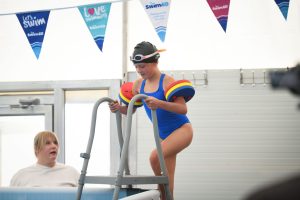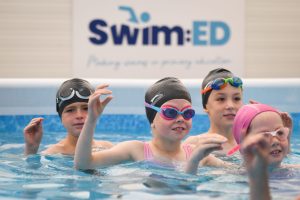Blog
The importance of swimming proficiency and water safety for children can’t be overstated. But did you know that the current state of swimming in primary schools might be holding our young learners back? Recent statistics have revealed a shocking reality – one in four children in England is leaving primary school unable to swim the National Curriculum recommended distance of 25 metres. What’s even more alarming, this figure could rise to six in ten by 2025 without significant intervention. This stark reality underlines an urgent need for solutions, especially considering swimming and water safety are vital parts of the school curriculum.
This blog post aims to shed light on the current state of primary school swimming and how schools can enhance swimming provision. By unpacking the challenges schools and parents face and outlining five effective ways schools can boost their swimming programmes (including an innovative look at pop-up pools), we aim to arm schools with the knowledge and inspire action. Because every child deserves the life-saving skill of swimming, and no child should be left behind. Let’s dive in and explore how we can turn the tide on this pressing issue.

The Importance of Swimming for Primary School Children
Swimming isn’t just another sport – it’s a crucial life skill that confers many benefits to primary school children.
- Physical and Cognitive Development: Swimming encourages children’s physical development, improving their strength, flexibility, and stamina. Regular swimming promotes cardiovascular fitness and healthy growth, contributing significantly to a child’s health and well-being. Furthermore, it aids cognitive development, enhancing concentration and classroom performance.
- Safety and Confidence: It’s no secret that water can be dangerous. The ability to swim and water safety knowledge are not just curriculum requirements—they are essential survival skills. Teaching children to swim equips them with the skills to keep themselves safe in and around water. It also instils confidence, not just in the water but in facing new challenges in general.
- Inclusivity: Swimming is an inclusive sport that accommodates children of all abilities, including those with special educational needs and disabilities. This inclusivity fosters a sense of belonging and encourages teamwork.
- Holistic Well-being: Beyond physical benefits, swimming improves a child’s mental and emotional well-being. It is a stress reliever and mood enhancer, helping children relax and enjoy a break from academic pressures.
In the face of these compelling benefits, ensuring every child can swim by the time they leave primary school becomes more than a target—it’s a mission. The urgency of this mission is further heightened by the fact that pupils from Black, Asian, and Minority Ethnic backgrounds are currently underrepresented in swimming achievement statistics. We must act now to reverse these trends, and in the following sections, we’ll discuss the challenges and potential solutions to doing so.
The Current State of Swimming in Primary Schools
The ability to swim is a fundamental life skill, yet recent reports paint a troubling picture of swimming proficiency among primary school children. According to Sport England’s latest Active Lives Children and Young People report, only 72% of children in Year Seven can swim competently, confidently, and proficiently over a distance of at least 25 metres. This figure represents a 6.3% decrease from pre-pandemic levels.
Primary schools play a crucial role in reversing this trend. The curriculum stipulates that by the end of their primary education, all children should be able to swim 25 metres unaided and use a range of strokes effectively. Furthermore, they should be equipped with the knowledge to perform safe self-rescue in different water-based situations. Despite these clear mandates, one in four children in England leaves primary school unable to swim the national curriculum’s recommended distance of 25 metres. Alarmingly, without intervention, this figure could rise to six in 10 by 2025.
There are disparities too. Children from ethnic minorities or socially disadvantaged backgrounds are disproportionately affected. The latest figures from Sport England reveal that a staggering 80% of Black children and 78% of Asian children do not swim. Similarly, while 86% of children from the most affluent families can swim 25 metres unaided by the time they leave school, this figure drops to 42% for the least affluent.
Pandemic-related pool closures throughout the 2019-20 and 2020-21 academic years have exacerbated these challenges. Even as pools reopened in the 2021-22 academic year, swimming levels remained below pre-pandemic figures. As we face these setbacks, it’s essential to remember that swimming is more than a sport or a physical exercise; it’s a vital life-saving skill every child deserves to master. In the following sections, we’ll delve into the challenges schools and parents face and explore five effective ways schools can enhance swimming provision.
Challenges in Providing Quality Swimming Education
Delivering quality swimming education comes with challenges, each contributing to the current state of primary school swimming. One of the most prevalent is access to facilities. For many schools, especially those in urban or densely populated areas, having a pool on-site is a luxury they can’t afford. For others, even if a swimming pool is nearby, the logistics and costs of transportation can be prohibitive.
Moreover, the pandemic has posed new problems, with many pools closing their doors temporarily or permanently in some unfortunate cases. With pool operators warning they may have to shut facilities due to rising energy costs, access to swimming education could become even more limited.
Furthermore, quality swimming education is about more than just pool access. It also demands qualified instructors to teach swimming and water safety skills effectively. There is a need for such professionals in some areas, which poses a significant barrier.
Budgetary constraints are another hurdle. Despite government funding, some schools find securing the necessary funding to provide regular swimming lessons challenging. This difficulty is often compounded in socially disadvantaged areas.
Finally, the need for more emphasis on swimming as a life-saving skill and a physical education component sometimes contributes to its neglect. This underemphasis can result in swimming being sidelined in favour of other sports or academic pursuits.
These challenges, although formidable, are manageable. A collaborative approach, innovative solutions, and a commitment to prioritising swimming education can help schools overcome these obstacles. The following section explores five practical ways schools can enhance swimming provision.
Five Practical Ways Schools Can Enhance Swimming Provision
Given the importance of swimming education and its associated challenges, schools must proactively seek solutions to overcome these obstacles. This section looks at five practical ways schools can enhance their swimming provision.
- Leveraging Government Funding: Government grants can significantly aid schools grappling with the economic implications of delivering high-quality swimming education. This includes the Primary PE and Sport Premium, which schools can use for top-up swimming lessons to enhance their swimming provision. Schools are encouraged to proactively seek these opportunities, applying for grants that can provide essential funding for improving their swimming teaching infrastructure. The focus should be on investing wisely to make impactful changes that equip pupils with this critical life skill. By leveraging such funding, schools can tackle some of the financial challenges that have been barriers to comprehensive swimming education.
- Virtual Water Safety Lessons: In today’s digital age, an expanding range of learning resources is available online. This abundance of virtual platforms provides an excellent opportunity to supplement traditional swimming lessons with comprehensive water safety education. Among these resources, the Royal Life Saving Society UK (RLSS UK) stands out with their diverse array of educational materials. They offer an extensive portfolio of online water safety classes to complement the physical swimming curriculum. Schools can easily incorporate these virtual lessons into their program, ensuring continuous and comprehensive learning. The RLSS UK’s offerings are particularly advantageous when physical pool access is restricted. This approach ensures that pupils continue to acquire crucial water safety knowledge, even when away from the pool, and provides teachers with additional resources to enrich their lessons. Applying this blended learning method effectively bridges the gap between physical and theoretical instruction, leading to a more holistic and rounded swimming education. https://www.rlss.org.uk/pages/category/water-safety-education
- Special Focus on Children with Special Educational Needs and Disabilities (SEND): Delivering an inclusive swimming curriculum is critical to ensuring all pupils, regardless of their needs, can participate, learn, and enjoy swimming education. This principle holds especially true for pupils with Special Educational Needs and Disabilities (SEND). Recognising this, school resources such as the Swim England Inclusion Hub [link to https://www.swimming.org/swimengland/inclusion] are indispensable. The Inclusion Hub offers a wealth of expertly curated, high-quality resources designed to foster an inclusive learning environment in swimming. These resources cover various aspects of inclusivity in swimming, catering to a broad range of needs and abilities. This online hub provides schools with guidance, activities, and strategies tailored to help SEND pupils navigate their swimming journey successfully. They include inclusive lesson plans, instructional videos, and practical guides to creating adaptive learning environments, all of which are easy to implement in any swimming programme. Schools can ensure a more inclusive and supportive learning environment by integrating resources like those on the Swim England Inclusion Hub into their swimming provision. This will empower all pupilss, including those with SEND, to achieve their swimming milestones, develop confidence in the water, and, most importantly, enjoy their swimming journey. By embracing such inclusive practices, we can genuinely make swimming an activity for everyone.
- Temporary Pool Solutions: The lack of a swimming facility on campus can often pose a substantial hurdle for schools aiming to provide quality swimming education. However, the emergence of innovative solutions such as ‘pop-up’ pools has offered schools a practical, cost-effective alternative. ‘Pop-up’ pools are temporary swimming facilities designed to be installed and removed as needed, offering incredible flexibility to schools. They can be erected on school grounds relatively quickly and taken down once their purpose is served, eliminating the need for permanent pool infrastructure. This flexibility allows schools to provide essential swimming lessons on their terms, effectively overcoming time, transportation, and staffing constraints. These ‘pop-up’ pools maintain safety and functionality despite their temporary nature. They come equipped with essential features and comply with safety standards, ensuring pupils get the same swimming instruction as they would in a permanent pool. Notably, their adoption can significantly help enhance the availability and accessibility of swimming lessons, ensuring that every child gets a fair chance to learn this vital life skill. If your school is grappling with needing access to a swimming pool on-site, ‘pop-up’ pools could be your answer to maintaining an active swimming education programme.
- Increased Transparency and Reporting on Swimming Proficiency: Transparency in sharing pupils’ swimming proficiency data is critical to understanding where schools stand in their swimming education provision. Since 2017, the Department for Education has mandated primary schools to publish the progress of Year 6 pupils concerning swimming and water safety skills. By publishing these insights, schools establish an environment of accountability and commit to continuous improvement. Parents, being informed about their children’s proficiency, can actively engage and support their children’s learning journey. It also allows schools to receive valuable feedback, identify potential gaps in their programmes, and develop targeted strategies to address those areas. Moreover, schools sharing their success stories and best practices can inspire and guide other schools striving to improve their swimming education. It fosters a culture of shared learning and collective growth in the mission to deliver quality swimming education to every child. Embracing transparency and regular reporting is a proactive way to keep all stakeholders informed, involved, and committed to raising the standard of swimming proficiency in primary schools.
Making the Change for the Future of Swimming Education
The current state of swimming in primary schools undeniably needs improvement. However, it’s a task to tackle with others. It’s a collective effort that requires educators, administrators, policymakers, and even the wider community to join forces and ensure our children acquire this essential life-saving skill.
Beyond its obvious health benefits, swimming empowers children with confidence, resilience, and independence. Its importance in primary education cannot be overstated. Therefore, we must continue striving towards overcoming the prevalent challenges, developing effective strategies, and ensuring all children, regardless of their socio-economic backgrounds or personal circumstances, are granted the opportunity to learn how to swim proficiently.
By understanding the present landscape and proactively exploring innovative solutions, such as leveraging government funding, implementing online safety lessons, and considering pop-up pool solutions, we can significantly enhance the swimming provision in our schools. This is how we can start making impactful waves in primary education.
We encourage you to take the first step as we navigate these waters together. Start by assessing your school’s current state of swimming education. Use our Primary School Swimming Review (PSSR) scorecard, a free tool designed to help you understand your school’s swimming provision and identify areas for improvement.
It’s time to dive in, make a splash, and ensure our children swim confidently towards a safer future. Take action today and follow the link below for the safety and welfare of our children tomorrow

